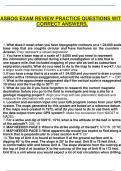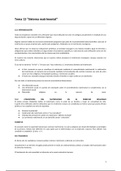BUSL6212
LU4: Consensus
Consensus – The basis for every contract. Consensus can be reached:
1. Every one of the parties has serious intention to be contractually bound
2. Parties have common intention
3. Every party makes his intentions known to every other party. Intention can be declared orally, in writing
or tacitly (through conduct/behavior).
So the end result will always be that one party communicates her intention to the other party in some way or
another, and the other party will communicate her acceptance/rejection to that intention in some way of another
thereby reaching consensus.
Offer and acceptance – Key terms: The offeror is the person who makes the offer, while the offeree is the
person to who an offer is made. Anything to do with the alienation of immovable property, offers must be in
writing
Requirements:
1. Offer must be made with the intention that the offeror will be legally bound by mere acceptance by the
offeree
2. Offer must be complete i.e. contain all the terms by which offeror is willing to abide by
3. Offer and acceptance must be clear and certain i.e. not vague
4. Offer and acceptance can be made in any manner i.e. expressly (verbal/written) or tacitly
5. Offer must be addressed to a particular person(s) or in general to an unknown person(s). The
exception to unknown persons is the example of a reward given to anyone that finds a lost dog.
6. Offer only complete once communicated and acceptance only complete once communicated
Falling away of offer:
Expiry
Revocation i.e. offer has been withdrawn before acceptance
Rejection
Counter offer i.e. the original offer is removed, and a new one replaces it
Death of either of the parties
Special rules – items that are not offers:
o Invitation to make offer = advertisements, price stickers etc.
o Offers for reward
o Option – During the period of an offer it must be accepted/rejected before a separate one is
considered.
o Auctions – Auction subject to reservation is when the auctioneer extends invitation to people to make
an offer. While an auction not subject to reservation is where the auctioneer makes an offer
Moment and place of formation of contract: A contract comes into being at the time when the acceptance is
communicated and at the same place where the parties happen to be at the point in time.
1. Information or Ascertainment theory: Where parties are in each other’s presence and telephone calls
2. Expedition or Dispatch theory: Not in each other’s presence
3. Reception theory: Electronic transactions – electronic agreement concluded at the time when, and at
the place where, the acceptance is received by the offeror. As receipt of message has plays an
important role in this theory it has been statutorily defined. According to this theory a data message is
deemed to have been received by the addressee when the complete data message enters an
information system (computer/network) designated/used by the addressee and is capable of being
1
, received and processed by addressee. Message becomes legally effective on receipt without the need
for acknowledgement.
Consensus and defects in a will: Two factors can affect consensus and therefor the existence of a
contract. However, the mistake in motive has no influence on consensus.
Absence of consensus: Mistake = void. If mistake Improperly obtained consensus: Voidable = the
meets certain requirements there is no consensus person affected can either continue the contract, or
and therefor no contract. rescind the contract (terminate).
Requirements: Misrepresentation: An untrue statement of
1. Must relate to identity of other person fact of affairs made by one party to a
2. Must be material or serious: Mistake proposed contract to another party before or
material or serious and therefore excludes at the same time contract was entered into
consensus where mistake: with the aim of inducing the other party to
Relates to identity of other person enter into the contract.
Relates to the content of the Duress: An unlawful threat of harm or injury
intended contract i.e. what, when, made by one contracting party or someone
how, where acting for that party and which causes the
Relates to the interpretation the law other contracting party to conclude the
attaches to proposed contract contract.
3. Must be reasonable: Mistake reasonable if a Undue influence: Improper conduct by one
reasonable man in the situation would have contracting party that persuades the other
made the same mistake. contracting party to conclude the contract.
Improperly obtained consensus
Misrepresentation Duress Undue influence
Types: There must be actual violence or Indicator of undue influence is
Intentional: Person threat of violence and it must be where a special relationship exists
intentionally sets out to imminent (about to happen) and i.e. where a person in a position of
deceive. Remedies = inevitable (going to happen. strength influences a weaker
uphold contract or Remedies = uphold or rescind person i.e. attorney – client,
rescind and claim contract and claim damages. doctor – patient, guardian – minor.
damages. Remedies = uphold or rescind
Negligent: Whilst is not contract.
intention of person to
deceive, they do not take
all reasonable steps to
make sure a state of is
what they presume to be.
Remedies = uphold or
rescind contract and
claim damages.
Innocent: Not persons
intention to deceive and
has taken all reasonable
steps to ensure a
situation is what it is
presumed to be.
Remedies = uphold or
rescind contract.
2











